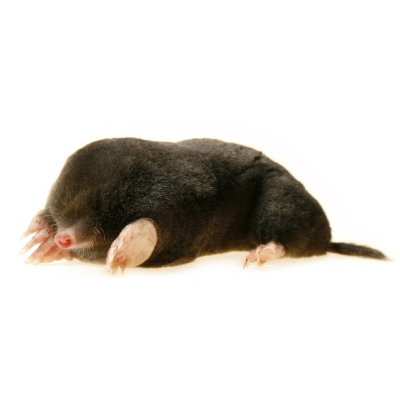
Color: A mole's fur is soft and brownish to grayish with silver highlights.
Size: Males: Average total length, 7 inches (17.6 cm) Average length of tail, 1 1/4 inches (3.3 cm).
Females: Average total length, 6 5/8 inches (16.8 cm) Average length of tail, 1 1/4 inches (3.3 cm).
Moles are small mammals that spend most of their lives in underground burrows.
Moles prefer moist, sandy loam soils in lawns, gardens, pastures and woodlands. They generally avoid heavy, dry clay soils. They construct extensive underground passageways -- shallow surface tunnels for spring, summer and fall; deep, permanent tunnels for winter use. Nest cavities are located underground, connecting with the deep tunnels.
Because moles have high energy requirements, they have large appetites. They can eat 70 to 80 percent of their weight daily. They actively feed day and night at all times of the year. Moles feed on mature insects, snail larvae, spiders, small vertebrates, earthworms, and occasionally small amounts of vegetation. Earthworms and white grubs are preferred foods.
Mole activity in lawns or fields usually shows up as ridges of upheaved soil. The ridges are created where the runways are constructed as the animals move about foraging for food. Burrowing activity occurs year-round, but peaks during warm, wet months. Some of these tunnels are used as travel lanes and may be abandoned immediately after being dug. Mounds of soil called molehills may be brought to the surface of the ground as moles dig deep, permanent tunnels and nest cavities.
Moles eat from 70% to 100% of their weight each day. The mole’s preferred diet is a carnivorous one: insect grubs, adult insects and earthworms.
Moles remove many damaging insects and grubs from lawns and gardens. However, their burrowing habits disfigure lawns and parks, destroy flower beds, tear up the roots of grasses, and create havoc in small garden plots.
Exclusion:
- For small areas, such as seed beds, install a 24-inch (61-cm) roll sheet metal or hardware cloth fence. Place the fence at the ground surface and bury it to a depth of at least 12 inches (30 cm), bent out at a 90o angle.
Cultural Methods:
- In practice, packing the soil with a roller or reducing soil moisture may reduce a habitat’s attractiveness to moles. Packing may even kill moles if done in the early morning or late evening.
- Because moles feed largely on insects and worms, the use of certain insecticides may reduce their food supply, causing them to leave the area. However, before doing so, they may increase their digging in search of food, possibly increasing damage to turf or garden areas. Check local sources of insecticides for controlling grubs. Follow the label instructions for use.
Repellents:
-
The repellent Thiram is federally registered for protecting bulbs from mole damage. Mole repellents with castor oil as the active ingredient are now on the market and may potentially prevent eastern mole damage under certain circumstances. In using any repellent, follow directions and application rates provided on the package label. Also be aware that using any repellent for controlling moles has limitations and may not eliminate damage or effectively control the problem.
Manufacturer Recommended Products And Treatment For Moles Control
Pests need food, water, and shelter. Often the problem may be solved just by removing these key items. Before even thinking about chemical pest control, it is important to be aware of
| Conducive Condition | Recommendation | |
| 1 | Tree branches on house | Keep tree branches away from house to reduce pest access |
| 2 | Firewood next to foundation | Keep firewood away from house to reduce pest harborage |
| 3 | Debris on crawlspace/next to foundation | Remove wood debris to reduce termite ha rborage area |
| 4 | Excessive plant cover, stump, etc. | Providing spacing between plant cover and structure |
| 5 | Soil above the foundation Ii ne | Keep soil below top of foundation to reduce harbo rage areas |
| 6 | Wood-to-ground contact | Keep soil from touching wood to eliminate termite access |
| 7 | Debris on roof/full gutter | Keep gutter & roof free of debris to reduce insect harborage |
| 8 | Standi ng water near/under structure | Eliminate standing water to reduce pest harbo rage |
| 9 | Mo isture problem under structure | Increase ventilation to reduce pest harbo rage area |
| 10 | Openi ngs at plumbi ng & electronics | Seal opening to reduce pest access |
| 11 | Excessive gaps at windows/doors | Seal gaps to reduce pest access |
| 12 | Lea ky plumb ing fixtures | Repair to reduce moisture for pests |
| 13 | Keep garbage cans covered | Covered to reduce attraction of insects of vertebrate pests |
| 14 | Mo isture damage wood | Repair rotten or damaged wood to reduce insect harborage |
| 15 | Grocery bags stored improperly | Seal paper sacks in containers to reduce i nsect ha rborage areas |
| 16 | Pet food unsealed or left out | Keep pet food in sealed containers and unavailable to pests |
| 17 | Excessive storage conditions | Keep storage areas uncluttered and manageable |
| 18 | Debris below kick plates | Remove kick plates to reduce rodent harborage |
1 product


